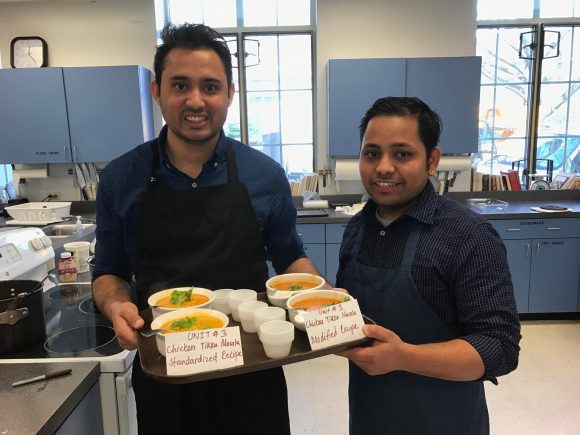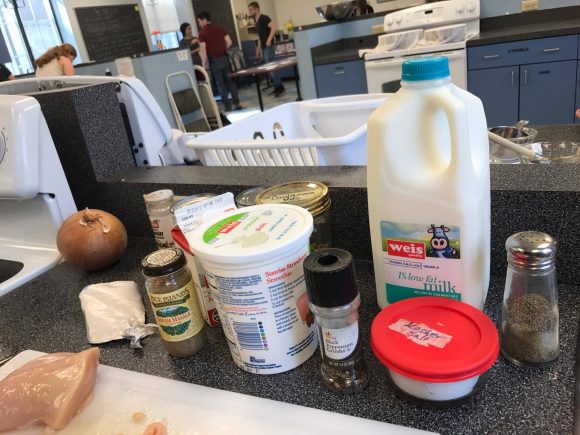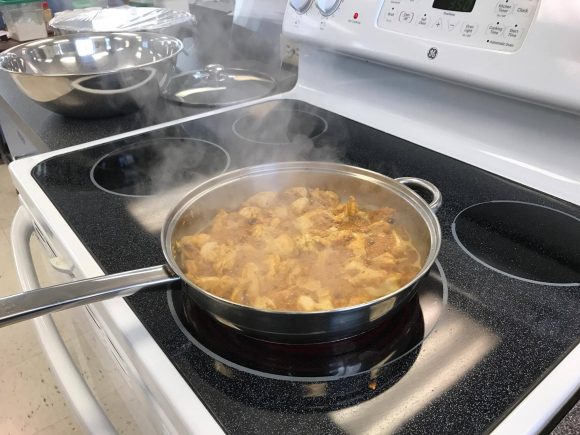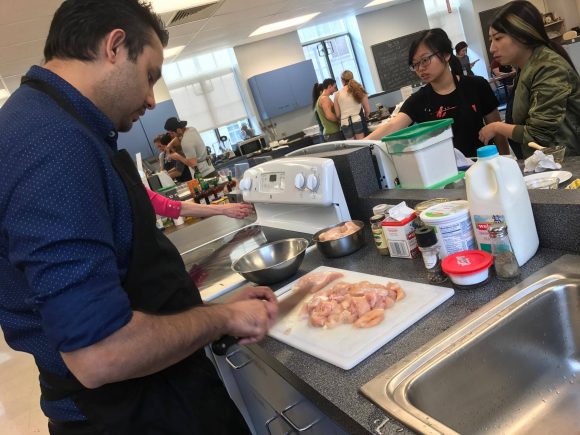Background: Chicken Tikka Masala is famous and loved cream based soup in Southeast Asia. Since Southeast Asian population has higher risk of chronic diseases such as hypertension and obesity, we plan to modify this recipe to help this community.
In modified recipe,
- We reduced the fat level by substituting heavy cream and whole milk to 1% milk.
- Similarly, we lowered the sodium level by reducing 1tbsp Kosher salt to 1 ½ tsp salt.
Mise en Place
Recipe Preparation:
The preparation procedures for the both recipes were same. It is described as follows:
- For this, we marinated the Chicken with an equal amount of yogurt, Kosher salt, cumin powder, and ground black pepper.
- We kept the both marinated Chicken for 15 minutes, and fried it with nonstick pan spray.
- Once it gets cooked and gets caramelized, we put all the chicken in the different pan.
- Until this time, we did not find any difference in the both recipe.
- First, we made the masala paste while making the soup for both recipes.
- We changed the amount of salt (sodium) from 1 tbsp. to 1.5 tsp in from standardized to Modified recipe to lower the sodium level in the food.
- Similarly, we substitute Heavy cream and whole milk in the standardized recipe to 1% milk to reduce the fat level of the recipe.
- As both recipes were finish cooking, standardized recipe soup became creamier and thicker than the modified recipe. Similarly, the standardized recipe looks yellowish color, and modified recipe looks red-orange color.
Appearance:
- Most of the respondent students liked the appearance of standardized recipe of Chicken Tikka Masala then the modified recipe.
- About 75% of the students liked the appearance of standardized and rated it with five stars.
- For modified recipe, only 50% of people liked the appearance and rated it with five stars.
- After getting feedbacks, we found that more students liked the appearance of standardized recipe
- Also, the students compared the color and gave us feedback that the standardized recipe looks more yellow and modified recipe looks red-orange color.
Whatever we predicted in RMP 2, we got the similar result after doing RMP 3.
Texture
- Five taste testers voted the texture of the both recipes by 71.4%
- An equal number of students liked the texture of the both recipe.
- Taste tester found that standardized recipes texture is more soft and creamy than the modified recipe
Aroma
- 6 of 7 tasters rate both recipe’s aroma five by 85.7%
- In the comment box, taster describes they like the aroma of the standardized recipe, but they loved modified too.
Sweetness
- The rating for sweetness for both recipes was equally divided.
- Out of 7 tasters, three people rate it 5by 42.9%, two rates it four by 28.6%, one rate it three by 14.3% and one rate it two by 14.3%.
- In the comment box, taster describe standardized recipe taste sweeter because of heavy cream.
- All the taste testers equally liked the both recipe
Taste
- More students like the taste of the standardized recipe.
- Six taste tasters rate it five by 85.7%, whereas, for modified recipe, only five people rate it five by 71.4%.
- Some tasters said that they did not find any difference in taste.
- While other tasters like the taste of standardized recipe because it has the high amount of fat in it.
Overall
- Most taste testers like the standardized recipe of chicken tikka masala by 71% then modified the recipe by 28.8%, and they were able to identify which one is standardized and which one is modified recipe.
- As predicted: Lowering the sodium level did not make significant differences in the taste of recipe
- We predicted that more people would like the standardized recipe; as a result, more people liked it.
- The both recipes appeared yellow and red-orange color, which we have predicted.
Describe the scientific principles for why the observed changes occurred.
The overall quality of the Chicken Tikka Masala soup depends on the ingredients we used while cooking it. We observed several difference while preparing both recipes.
Heavy cream contains less amount of water and more amount of fat contain. Also, it contains 36% of fat, and skim milk contains only 1% of fat on it. Similarly, 1% fat milk contain more amount of water in it. Because of this, it affects in the consistency of the food. While substituting heavy cream with 1% fat milk, it alters the texture, flavor, taste, mixing ability, the mouthfeel of the recipe. With high fat contain and thick consistency of heavy cream, it makes a thicker soup. Similarly, since heavy cream has more amount of lactose and glucose, it helps to alter the color into yellow. It also changes the flavor, mixing ability and make the soup more soft and palatable. Furthermore, we have used 1% milk in substitution because it contains less amount of glucose and fat than the heavy cream. Similarly, it also contains more amount of water in it. This affects the consistency of the recipe and makes more liquid soup. Due to less amount of fat, the soup was not as soft and palatable. According to the class note from fat lecture, fat helps to make food more smooth and palatable.
Nutritional comparison:
Our goal is to make the product healthier by changing the standardized recipe’s ingredients to modified recipe. The nutritional changes that we observed between the two recipes are; the standardized recipe has more amount of total calories and more nutrients amount per portion in sodium and total fat compared to the modified Chicken Tikka Masala.
- The standardized recipe has 441 total Calories, total fat of 39g and 1379 mg sodium compared to modified recipe.
- The modified Chicken Tikka Masala has good nutrients value and low calories like with accumulation of 181 total calories, total fat of 8 g and 805 mg of sodium, which has less sodium than in the standardized recipe.
- In regards, both of the recipes has the different amount of saturated fat, which is 24 g saturated fat in the standardized recipe and 5 g in modified recipe.
- Furthermore, we found 2g dietary fiber in the standardized recipe, whereas in modified recipe, it has the dietary fiber of 1g.
- Also, the standardized recipe has 14g protein, and modified recipe has 15g protein.
- Similarly, the total sugars in the standardized recipe is 8g, and modified recipe has 9g of total sugars. According to our goal, we came up with good results for modified recipe as it decreased in total fat, sodium and total calories, which is much healthier.
- In modified recipe, there are fewer calories, total fat, sodium, and saturated fat because we replaced the whole milk yogurt with low-fat yogurt, in which whole milk yogurt contains 18% of a fat level, and low-fat yogurt contains only 2% of a fat level. Also, we have substituted heavy cream with 1% milk, and also reduced the amount of salt from 1 tbsp to 1 ½ tsp salt, which significantly decreased the sodium level.

Future changes to improve the modified recipe.
- In the future, things we will change to improve the recipe would be using whole milk as a substitute because it contains more fat and gives a better texture to the recipe then 1% fat milk. Similarly, I would use Slurry to make thicker soup to make it similar to the standardized recipe. While making the substitute, we think to lower the total amount of fat and sodium level of the soup. However, most of the people like both recipe, I believe that we would have make it even better. To make soup thicker I can use potato starch. Because the higher amount of amylose starch contain by the potato, it will gelatinize and make a thicker soup.
Survey: https://docs.google.com/forms/d/1j2e3b_UjOpRSssGxeS3aj6T8J3FfCjSsz-ziuhesOjg/edit#responses
Citations:
Dr. Mary Coleman – Kelly, (2014). Milk & Milk Alternatives to Milk. [Powerpoint Slides] Retrieved from Canvas
Dr. Mary Coleman – Kelly, (2014). Lipids & Fats . [Powerpoint Slides] Retrieved from Canvas
Roman, Alison. “Chicken Tikka Masala.” Epicurious. Bon Appétit, 12 Mar. 2013. Web. 27 Apr. 2017.
Standardized Recipe Nutrients Profile: STANDARD RECIPE Nutrient Profiles-1pb0ifc
Modified Recipe Nutrients Profile: MODIFIED RECIPE Nutrient Profiles-1rkk187
Recipes: Recipe-source_-original-and-modified-15iedhf









